A haunting surprise surfaced from the shadowy depths of the Pacific Ocean on the Oregon coast earlier this week – a fang-toothed predator nearly five feet long, fresh from the so-called ‘Twilight Zone’ of the sea.
The beastly creature, identified as a longnose lancetfish, stunned locals when it washed up on Seaside Beach, with its sail-like dorsal fin arching menacingly above its eel-like body.
For most beachgoers, the rare sighting of the prehistoric-looking fish is the stuff of nightmares but for self-described ‘fish nerds’ at the Seaside Aquarium, it was a dream come true.
‘It doesn’t look like a very friendly fish. If I saw that fish alive, I wouldn’t touch it,’ admitted Tiffany Boothe, assistant manager at the aquarium, in an interview to USA Today following the discovery.
With its gaping mouth lined with sharp, curved teeth and massive, unblinking eyes, the lancetfish could easily be mistaken for a sea monster torn from myth. But it is very real – and very rarely seen in such pristine condition above the waves.
The bizarre turn of events began earlier this week when a curious beachgoer wandered into the aquarium gift shop, clutching a photograph of the strange, freshly beached fish.
The specimen looked so unusually intact that aquarium staff rushed out immediately to retrieve it before Oregon’s voracious seagulls could tear it apart.
‘When he showed us the picture, it was such a fresh, great specimen that we were like, “Sweet, we’re gonna go pick it up,”‘ Boothe recounted.
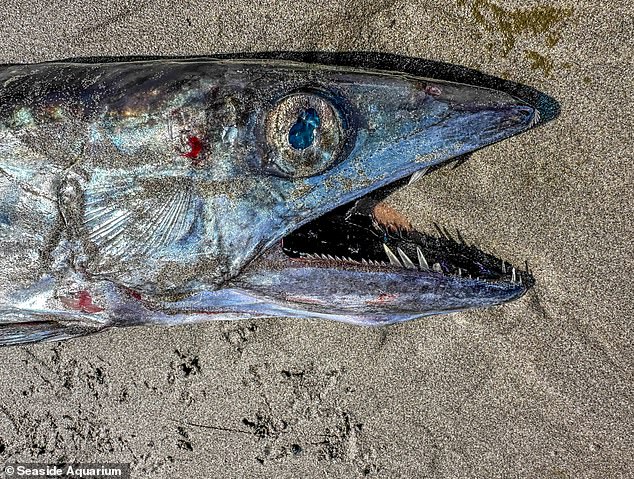
A beastly creature, identified as a longnose lancetfish, stunned locals when it washed up on Seaside Beach, Oregon with its sail-like dorsal fin arching menacingly above its eel-like body
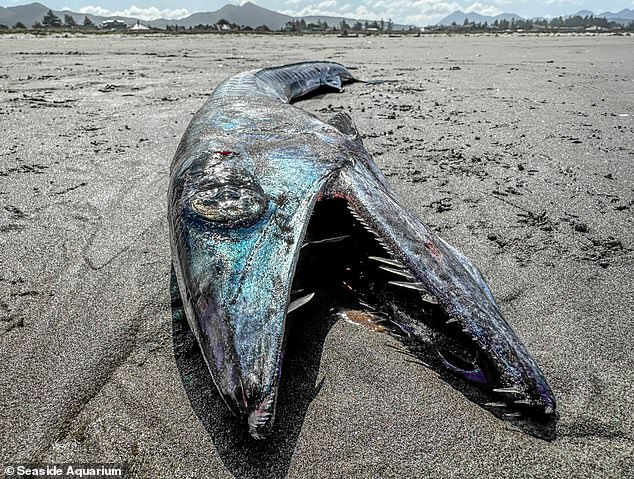
For most beachgoers, the rare sighting of the prehistoric-looking fish is the stuff of nightmares but for self-described ‘fish nerds’ at the Seaside Aquarium, it was a dream come true
‘It’s kind of hard to find ones that are fresh and that intact. The seagulls just absolutely go crazy after them.’
For the aquarium team who have seen a handful of lancetfish wash up over the years, this particular specimen was a rare opportunity for hands-on study.
Nicknamed the ‘Twilight Zone’ fish due to its hunting grounds deep within the mesopelagic zone, a murky region of ocean lying between 650 to 3,300 feet below the surface, the longnose lancetfish usually dwells well out of human reach.
They are usually seen only when deep-sea fisherman accidentally catch them while using long-lines to try to catch tuna.
The fish prefer warmer waters but is known to migrate as far north as the Bering Sea, according to the National Oceanic and Atmospheric Administration (NOAA).
Part sea serpent, part fang-toothed nightmare, the lancetfish belongs to the genus Alepisaurus, meaning ‘scaleless lizard.’
This dinosaur-worthy name only adds to the creature’s eerie, ancient mystique.
With a ribbon-like body, sail-shaped fin, and glassy eyes, the lancetfish looks like it could have swum straight out of the Jurassic period.
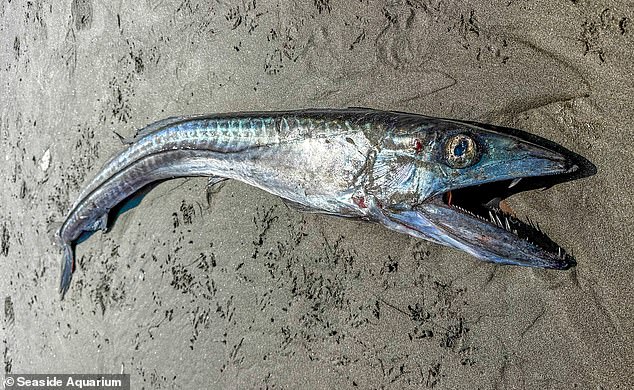
The specimen looked so unusually intact that aquarium staff rushed out immediately to retrieve it before Oregon’s voracious seagulls could tear it apart.

While the fish’s horrifying appearance was enough to draw attention, the real mystery lay inside its stomach, the content of which are seen above
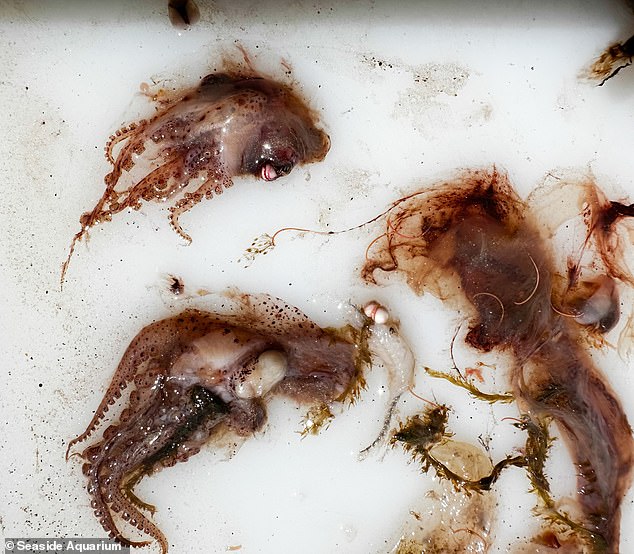
The team at Seaside Aquarium couldn’t resist the chance to peek inside the fish’s stomach
Though other fish, sharks, and seals may prey on lancetfish, humans have little use for them.
Their flesh is watery, gelatinous, and notoriously unappetizing making them one of the few apex marine predators that doesn’t end up on a dinner plate.
While the fish’s horrifying appearance was enough to draw attention, the real mystery lay inside its stomach.
Lancetfish, according to NOAA and the Seaside Aquarium, are infamous for their slow digestive systems – a biological quirk that allows scientists a rare, intact glimpse at their last meals.
The team at Seaside Aquarium couldn’t resist the chance to peek inside.
‘When you look at their stomach contents, you find whole fish, squids… you see things you wouldn’t normally see,’ Boothe explained.
The aquarium later shared the stomach-churning content, revealing a gruesome array of prey: several squid, octopus remains, and entire fish still whole enough to be easily identified.
‘By studying what the longnose lancetfish is eating, scientists can better understand how the marine food web changes over time (if at all). It may also help understand changes in the food web brought on by events like El Niño or La Niña,’ the aquarium wrote.

A gruesome array of prey: several squid, octopus remains, and entire fish still whole enough to be easily identified would be seen inside

Lancetfish are infamous for their slow digestive systems – a biological quirk that allows scientists a rare, intact glimpse at their last meals
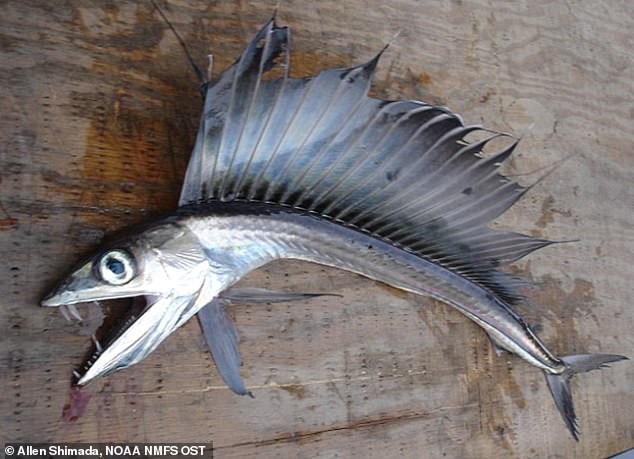
The lancet fish, which has a large dorsal fin and fangs, is related to yellowfin tuna and swordfish

This lancet fish was found on a North Carolina beach back in 2014
The lancetfish’s stomach contents weren’t the only shocking detail.
These elusive predators are also known for their cannibalistic tendencies, often feeding on other lancetfish.
According to Boothe, they’ve been observed entering frenzied feeding states where they not only attack others, but sometimes fatally injure themselves in the process.
‘They get into feeding frenzies and not only will they eat each other, but sometimes they’ll whip around and they actually gash themselves,’ Boothe noted.
Attempts to keep lancetfish alive in captivity have failed miserably.
The Seaside Aquarium has never managed to keep one alive for more than an hour.
The first specimen the staff recovered back in the 1990s was ultimately preserved and mounted by a taxidermist, an eerie but beautiful relic of the deep.
‘It’s actually very beautiful,’ Boothe said of the preserved specimen.
Though it posed no threat to the beachgoers who discovered it, the lancetfish has become an unsettling symbol of the hidden world beneath the waves, a place where ancient predators still roam and prey on anything unlucky enough to cross their path.







